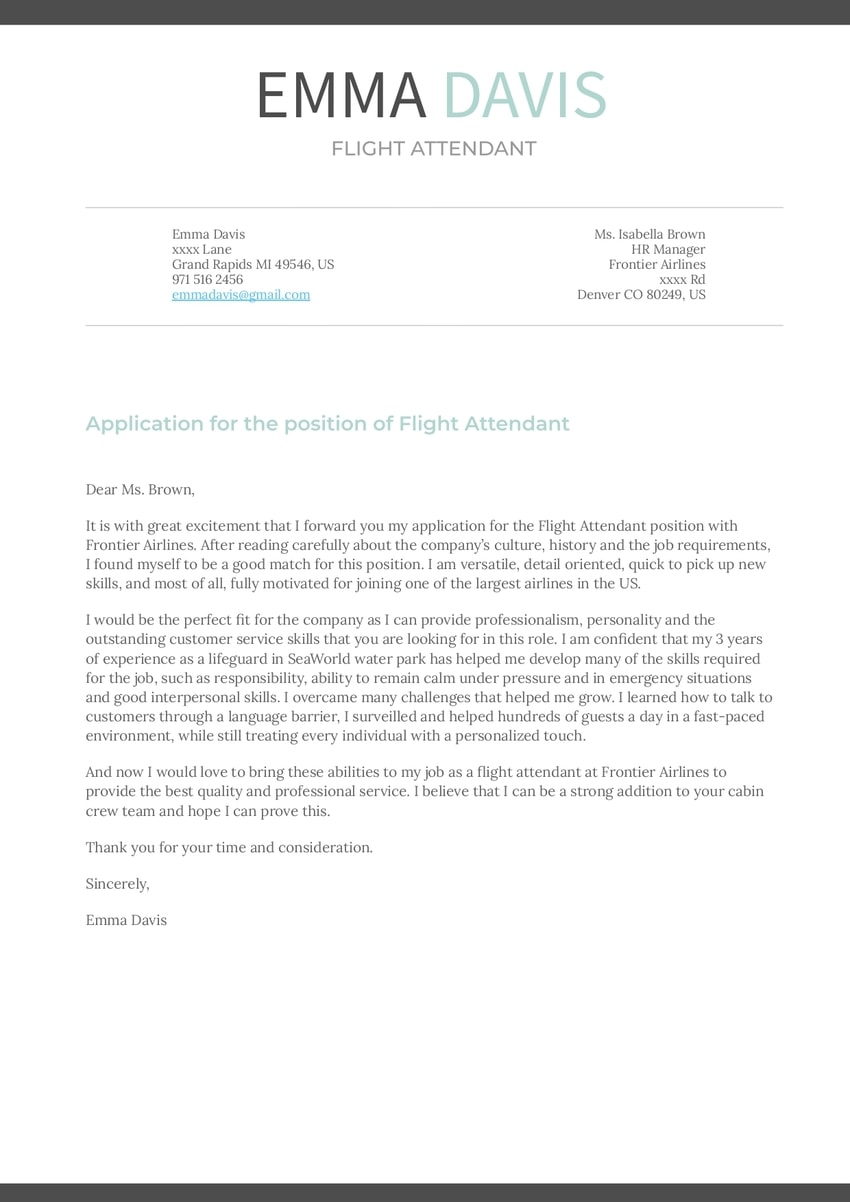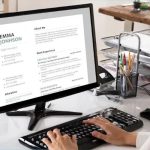The purpose of a cover letter is to give a sneak-peak into what your resume will contain. It truly is the first impression the employer will have of you. And it is also true that a poorly written cover letter can send your application straight to the recycle bin.
This is where you introduce yourself and start selling to the company what you have to offer. It’s like a self-introduction that helps you sell yourself. In this very first stage of the process, it’s important that you stand out from the crowd, so you need to put a lot of thought and effort into it.
My step by step guide about how to write the perfect cover letter for the position of Flight Attendant will get you ahead of the crowd.
Table of Contents
Never send the same cover letter for all jobs
NEVER send a generic application in response to all the job ads you find.
It’s very important that you tailor your resume or send a cover letter according to each position you are applying for.
It can be time-consuming I know, but, trust me, it’s worth it.
Keep in mind that most of the airlines receive hundreds of resumes for an average job opening, so you need to pay attention to the quality of your cover letter as well as your CV in order to get interviews.
If you are not getting interviews, it may well be that you haven’t paid enough attention to this very important first step.
Your cover letter is not a copy of your resume
Don’t copy the information in your CV and simply rewrite it into a letter format.
The purpose of the cover letter is to complement your resume, not to repeat it.
It’s an opportunity to zoom in on your skills, or on whatever that is making you the ideal candidate for the job.
Highlight why you want to work with them above other companies and motivate the recruiter to read your resume in detail.
You should match your skills with their needs. Include qualities like team working, interpersonal skills, good customer service skills, and being confident in handling difficult situations and always.
Remember to give examples.
Match your cover letter style and font to your resume
Use the same font style, sizes, and colors that you picked for your resume.
It will look unprofessional if they don’t match.
Make sure they are readable fonts; the tried and true classic fonts such as Arial and Times New Roman work best.
The perfect size is between 12 and 14 and the style of your letter should be simple and elegant.
You’ll find downloadable resume templates and matching cover letter templates here.
Before you even start writing, do your research about the company
You should be familiar with the airline’s history, aircraft fleet, go to the airline website and learn about their vision, corporate values, the way they work and their culture. Read the job listing carefully.
Once you understand about the company and the job, you can match your skills and qualifications to their needs.
These are some examples showcasing the relevant experience you have for the job, or talking about your skills and why you are a good fit for the position:
- If the airline is looking for “language of destination” flight attendants: e.g. Spanish-speaking flight attendants and you can speak the language, make sure you mention that in your cover letter. But don’t just repeat your CV here, always add information to what is already in your resume. For example, things such as how you learned the language, and whether you have used it before in a work situation, Don’t just say that you have an intermediate Spanish level.
- If you are applying for a VIP flight attendant position in a private jet company, and you’ve never worked in the industry before, but you have worked in luxury hotels, restaurants or top-class companies, don’t forget to highlight that! It can be really helpful.
Remember corporate aviation is all about etiquette and protocol, so any job in relation to excellence in a high standard of customer service is a PLUS! If you have studied or worked as a sommelier, or if you were a stewardess on a yacht, these sorts of things can definitely be an advantage. - If you don’t have any previous airline experience.
Talk about any hospitality or customer service experience you have and explain how you have already developed some of the skills required for the flight attendant’s job.
Some of the qualities of a flight attendant are what we call ‘transferable’, which means that they can be used in other industries. Skills such as being professional, a team worker, responsible, and being flexible are all transferable.
Provide a short example of what you have done in your work life, like offering first aid, dealing with an unhappy customer or helping a new coworker. Put yourself in team context – show your collaboration skills and how you shared the duties with your colleagues to work as a team in order to succeed.
Don’t copy the content that most of the resume websites are offering – they all suck!
They are written by people who may be good at Human Resources, but they don’t know anything about the role of a flight attendant.
A sample of a cover letter on these websites usually recommends that you showcase abilities such as a clear speaking voice or the ability to reach overhead bins, etc. Which all sounds pretty good, but is actually missing the mark.
If you are interested in knowing which skills employers are looking for in a flight attendant, read my article: How to Write the Perfect Flight Attendant Resume and Stand out from the Crowd.
Keep it short, just 3 or 4 paragraphs, no longer
This isn’t a novel about you.
You just need to briefly and clearly explain a few things such as:
- Why you want to work as cabin crew for this particular airline
- Why you are the perfect match for this position: highlighting your skills and how you can add value to the airline
- Thank the recruiter for taking the time to read your letter.
One page maximum! Keep it short and concise – most recruiters prefer to read half a page to a full one.
Cover your gaps or red flags
Your cover letter is especially important if you have an employment gap or red flags on your resume.
If you have something that they might not understand in your CV (like job-hopping, large time gaps or a complete career change), it’s a great opportunity for you to explain it here.
Follow the instructions religiously
If there are any instructions given in the application information, please follow them carefully.
There’s nothing worse than receiving applications from people who haven’t even read the job listing to the end.
Maybe you’ve been asked to include a certain phrase or word in the cover letter, to address it to someone in particular, or perhaps to answer a question.
Not doing what you’re asked will make you lose the job opportunity immediately.
Be polite
Don’t forget to thank them for taking the time to read your cover letter.
Let let them know your availability for an interview.
Save your cover letter in PDF
If you are sending the cover letter online, make sure it’s in PDF format unless you are given specific instructions to do otherwise.
Your document in PDF will preserve the exactly the same look, no matter on which device it’s opened or printed.
Before sending your cover letter
- Reread and polish your cover letter.
Search for any spelling or grammar mistakes, or ask someone to read and correct it.
Don’t rush – you may want to send it as soon as possible, but you’ll make more mistakes. Make sure your cover letter is looking perfect. - Make sure you send it to the correct email address, and to the appropriate person.
- Make sure your contact details are in the heading of the letter.
- Name the file with your name: NicoleSmith.pdf not just resume.pdf
It will help the recruiter find you CV and differentiate it from the rest. - Don’t use weird or unprofessional email addresses.
You shouldn’t be surprised if employers are not getting back to you because your email is unprofessional, such as [email protected], [email protected] - If you are sending your cover letter via a website and you have to fit it into a text box, you can copy and paste your cover letter and edit it to make it shorter.
Remember people are less patient when reading on screen. They just scan the text. - Check your writing style.
Don’t use too many clichés or empty expressions that are not bringing anything. Always use formal language and business-speak, never use emoticons or write in UPPERCASE. Use short paragraphs and leave plenty of space between paragraphs to make it easier to read.
I know most of these tips are just “common sense” and probably many of you send excellent CVs and cover letters, which transmit enthusiasm, interest, and motivation. Thank you!
But for others, it’s a good reminder to know that you don’t get a second chance to make a good first impression and stand out from the pile. So do not miss this opportunity.
Cover letter sample for a flight attendant without previous experience

Don’t forget, this example is not to copy-paste by any means!
You can use it to get inspired but remember:
Try to be 100% relevant and to the point.
Show the potential employer that you’ve done your research and you know about the company.
Showcase your abilities or experience. In this case, your tourism and hospitality work experience, which is relevant for the role.
Don’t forget to mention your availability to attend an interview or to relocate for this position.
This is how you should build your flight attendant cover letter too.
Good luck!





